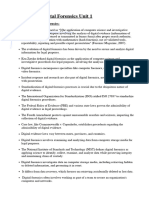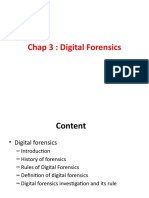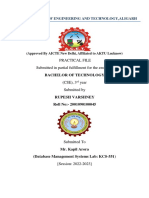0% found this document useful (0 votes)
40 views5 pagesIntroduction To Digital Forensics
Digital forensics involves investigating digital devices to uncover evidence related to crimes or cybersecurity issues. The process includes identifying important data, preserving it safely, analyzing it for clues, and reporting findings, all while maintaining a chain of custody for the evidence. Tools like Autopsy, FTK Imager, and Volatility are commonly used to assist in these investigations.
Uploaded by
hackerghost.1121Copyright
© © All Rights Reserved
We take content rights seriously. If you suspect this is your content, claim it here.
Available Formats
Download as PDF, TXT or read online on Scribd
0% found this document useful (0 votes)
40 views5 pagesIntroduction To Digital Forensics
Digital forensics involves investigating digital devices to uncover evidence related to crimes or cybersecurity issues. The process includes identifying important data, preserving it safely, analyzing it for clues, and reporting findings, all while maintaining a chain of custody for the evidence. Tools like Autopsy, FTK Imager, and Volatility are commonly used to assist in these investigations.
Uploaded by
hackerghost.1121Copyright
© © All Rights Reserved
We take content rights seriously. If you suspect this is your content, claim it here.
Available Formats
Download as PDF, TXT or read online on Scribd
/ 5





















































































